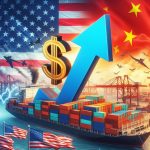Freight Rates, Demand, & Tariffs – Answering International Shipping Questions
Today, we answer current questions about international shipping.
If you have questions, topics, or ideas you’d like to see covered in Universal Cargo’s blog, we’d love to hear from you. You can reach out in our blog’s comments sections, by email, or on social media.
Let’s get right into it…
Is shipping demand low because of tariffs?

Short answer: yes.
But there are additional factors to take into consideration.
Particularly with trans-Pacific shipping, demand is down between 30% and 50% for importing from China with the current 145% tariffs the Trump Administration has placed on goods from there. However, this is not a drop in shipping demand that suddenly happened when the tariffs hit after previously normal shipping patterns. Many shippers frontloaded imports, stocking up inventories early in anticipation of the tariffs’ arrival.
This was the case with imports from all kinds of countries because the Trump Administration announced it would be implementing reciprocal tariffs on countries around the world in advance of what it dubbed “Liberation Day” (April 2nd, 2025).
We’re also still in a little bit slower time of year before international shipping ramps up with its peak season, typically mid/late summer and into the fall. Bigger years can see the peak season arrive early, but we’re still a couple months away from when shipping demand normally becomes high.
Are Freight Rates Low Right Now?
Yes, but…
In late March, I wrote a post that highlighted freight rates being lower than we’d seen at any point last year. Businesses that import goods have been finding themselves trying to balance lower freight rates with higher tariff costs, and that’s still the case.
Freight rates remain comparatively low. Data as of late April show spot freight rates around 61% lower than the start of the year and a bit under 75% lower than their peak in July of last year. It should be kept in mind that while the beginning of the year is typically a slower time for international shipping (though there is often a little surge in there to beat the Chinese New Year), there was some extra shipping happening to beat tariffs. And, of course, July is that peak season shipping time of year.
All the same, freight rates are significantly lower. But demand’s drop would make some think freight rates could be even lower right now. The reason they aren’t is carriers, utilizing their alliances, have become very good at reducing capacity (supply) in the international shipping industry with blanked (cancelled) sailings. Carriers are doing a great deal of blank sailings right now. Drewry has a blanked sailings tracker that shows 75 sailings were cancelled between late April and the upcoming early June.
Carriers’ capacity control is keeping freight rates from plummeting harmfully low for them. In fact, they’re doing such a good job of it, FreightWaves just published an article by Stuart Chirls about freight rates weathering the storm of low China to U.S. shipping demand from the current tariffs.
Are we about to see another supply chain crisis like we saw after the pandemic hit?
Not likely.
I’ve seen the articles predicting a repeat of the pandemic’s supply chain crisis because of the tariffs too. I disagree with those predictions and think politics play a factor in trying to elevate fear or even panic over the tariffs.
That doesn’t mean there are no similar factors that will cause some international shipping issues in the near future. The biggest similarity is increased blanked sailings. There were hundreds of cancelled sailings when the pandemic first hit. Carriers misjudged what would happen with demand during the pandemic and reduced capacity way more than demand, well, demanded.
Shipping demand quickly skyrocketed with lockdowns and then government stimulus checks spurring spending, so there was a massive imbalance with demand overwhelming supply. On top, all the blanked sailings caused containers and equipment to be maldistributed.
The blank sailings right now are happening in better correspondence to demand. The blanked sailings are based on what’s happening with demand rather than what carriers think (and incorrectly) will happen with demand. Even with the high blanked sailing happening, there’s not as much as early on in the pandemic. Still, there could be some negative impacts on distribution of shipping containers and equipment like chassis. With a surge in demand, we could see some congestion, particularly at Chinese ports where many exporting factories have paused operations. That would put upward pressure on freight rates.
Ultimately, the extreme factors, including work restrictions at the ports, are not present to push shipping into the “crisis” mode we saw during the pandemic. Plus, with early stocking of inventories to beat tariffs and people no longer restricted from going out in the world, there’s no reason to think demand would suddenly skyrocket either.
Are these unprecedented times for international shipping?
Ugh. If I never heard the word unprecedented again, I’d be happy. No.
Freight rates have always been highly volatile. That freight rates are volatile felt like the main theme of the blog when I first started writing about international shipping in 2011. We’re seeing surges and falls in freight rates based on demand in response to tariffs over the course of 2025 so far. However, ocean freight carriers have become pretty good at managing capacity over the last decade, keeping rates from getting too low.
As for tariffs themselves, the trade war situation between the U.S. and China is not that dissimilar to what we saw during President Trump’s first term. During that time, some businesses moved their sourcing to other countries as well as domestic manufacturers. The larger-scale tariffs the Trump Administration placed on countries around the world has created some uncertainty, but it seems largely done for leverage (and some revenue generation) to get new trade deals. That indicates a transitory period.
In fact, most of the really big reciprocal tariffs were paused almost immediately for trade deal negotiations to take place. Eventually, more stable tariff levels will be worked out, and global trade markets will adjust, as they did with higher tariffs on Chinese goods after President Trump’s first term.
There are always disruptions to global trade, whether wars, natural disasters, labor unrest, tariffs, sanctions, or others. Shippers always have to be vigilant with their supply chains. As long as there have been countries and people within those countries trading with each other, disruptions to that trade have existed. Even forms of tariffs have existed all that times.
Let us know your thoughts and questions on these topics and more.




